engine VOLVO S60 2007 Repair Manual
[x] Cancel search | Manufacturer: VOLVO, Model Year: 2007, Model line: S60, Model: VOLVO S60 2007Pages: 200, PDF Size: 4.03 MB
Page 150 of 200
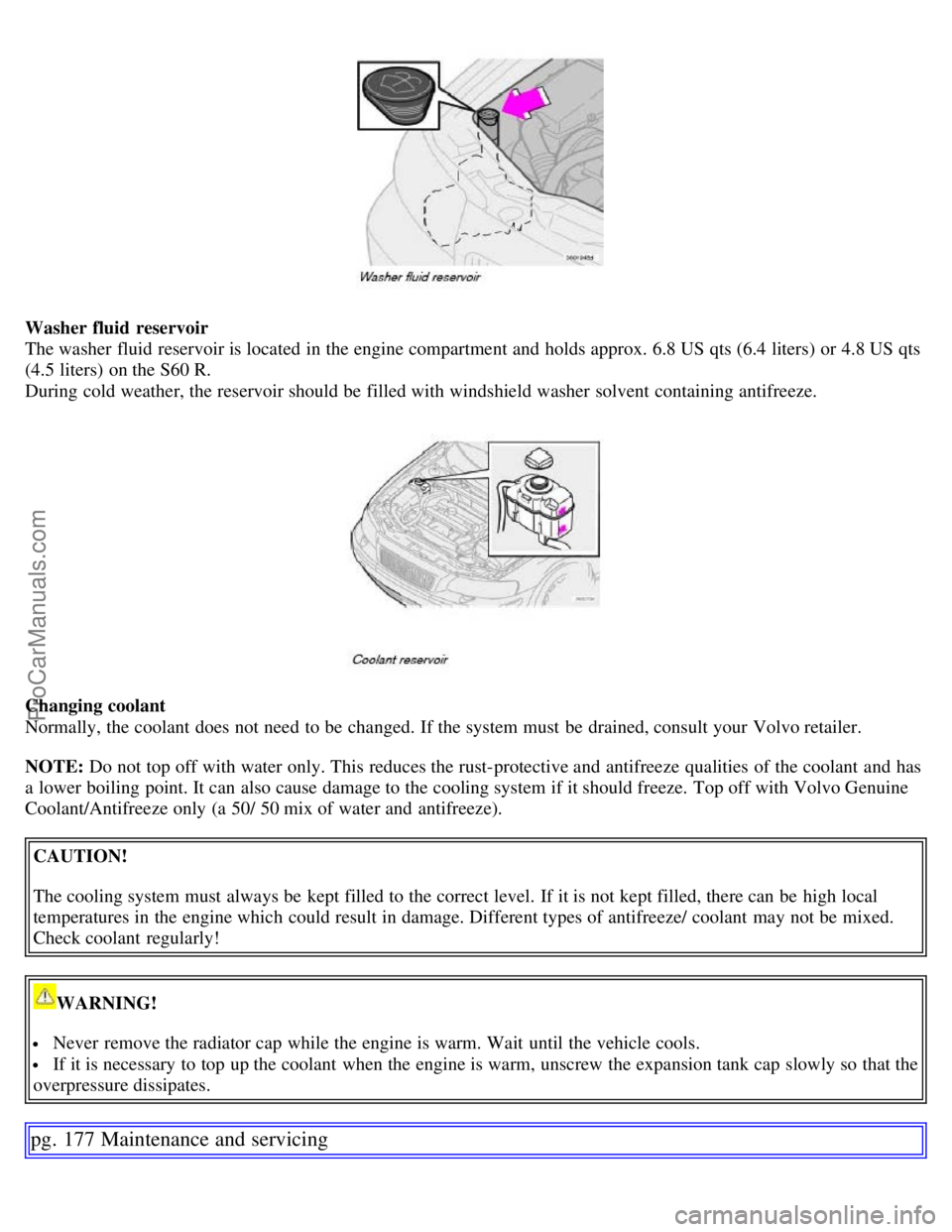
Washer fluid reservoir
The washer fluid reservoir is located in the engine compartment and holds approx. 6.8 US qts (6.4 liters) or 4.8 US qts
(4.5 liters) on the S60 R.
During cold weather, the reservoir should be filled with windshield washer solvent containing antifreeze.
Changing coolant
Normally, the coolant does not need to be changed. If the system must be drained, consult your Volvo retailer.
NOTE: Do not top off with water only. This reduces the rust-protective and antifreeze qualities of the coolant and has
a lower boiling point. It can also cause damage to the cooling system if it should freeze. Top off with Volvo Genuine
Coolant/Antifreeze only (a 50/ 50 mix of water and antifreeze).
CAUTION!
The cooling system must always be kept filled to the correct level. If it is not kept filled, there can be high local
temperatures in the engine which could result in damage. Different types of antifreeze/ coolant may not be mixed.
Check coolant regularly!
WARNING!
Never remove the radiator cap while the engine is warm. Wait until the vehicle cools.
If it is necessary to top up the coolant when the engine is warm, unscrew the expansion tank cap slowly so that the
overpressure dissipates.
pg. 177 Maintenance and servicing
ProCarManuals.com
Page 153 of 200
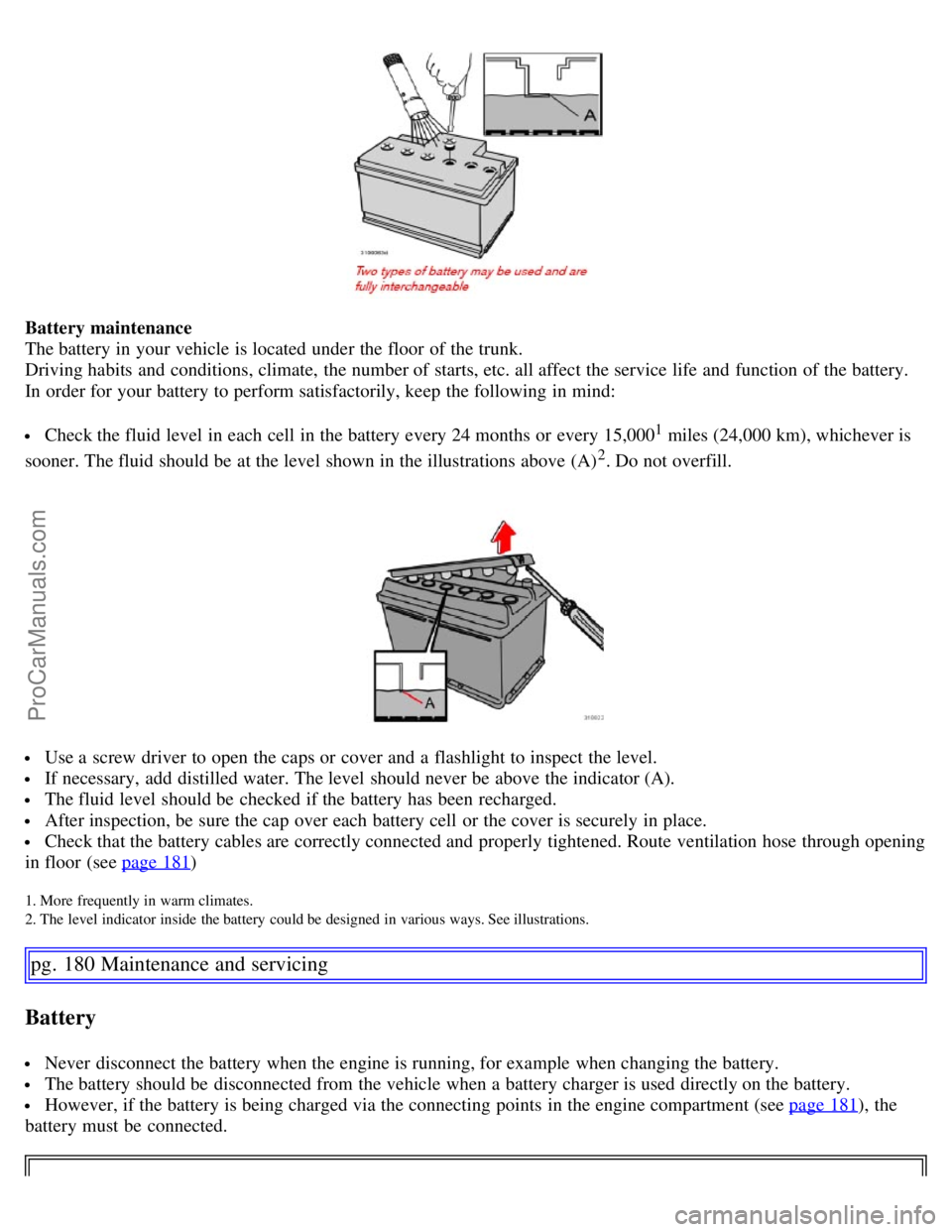
Battery maintenance
The battery in your vehicle is located under the floor of the trunk.
Driving habits and conditions, climate, the number of starts, etc. all affect the service life and function of the battery.
In order for your battery to perform satisfactorily, keep the following in mind:
Check the fluid level in each cell in the battery every 24 months or every 15,0001 miles (24,000 km), whichever is
sooner. The fluid should be at the level shown in the illustrations above (A)
2. Do not overfill.
Use a screw driver to open the caps or cover and a flashlight to inspect the level.
If necessary, add distilled water. The level should never be above the indicator (A).
The fluid level should be checked if the battery has been recharged.
After inspection, be sure the cap over each battery cell or the cover is securely in place.
Check that the battery cables are correctly connected and properly tightened. Route ventilation hose through opening
in floor (see page 181
)
1. More frequently in warm climates.
2. The level indicator inside the battery could be designed in various ways. See illustrations.
pg. 180 Maintenance and servicing
Battery
Never disconnect the battery when the engine is running, for example when changing the battery.
The battery should be disconnected from the vehicle when a battery charger is used directly on the battery.
However, if the battery is being charged via the connecting points in the engine compartment (see page 181), the
battery must be connected.
ProCarManuals.com
Page 156 of 200
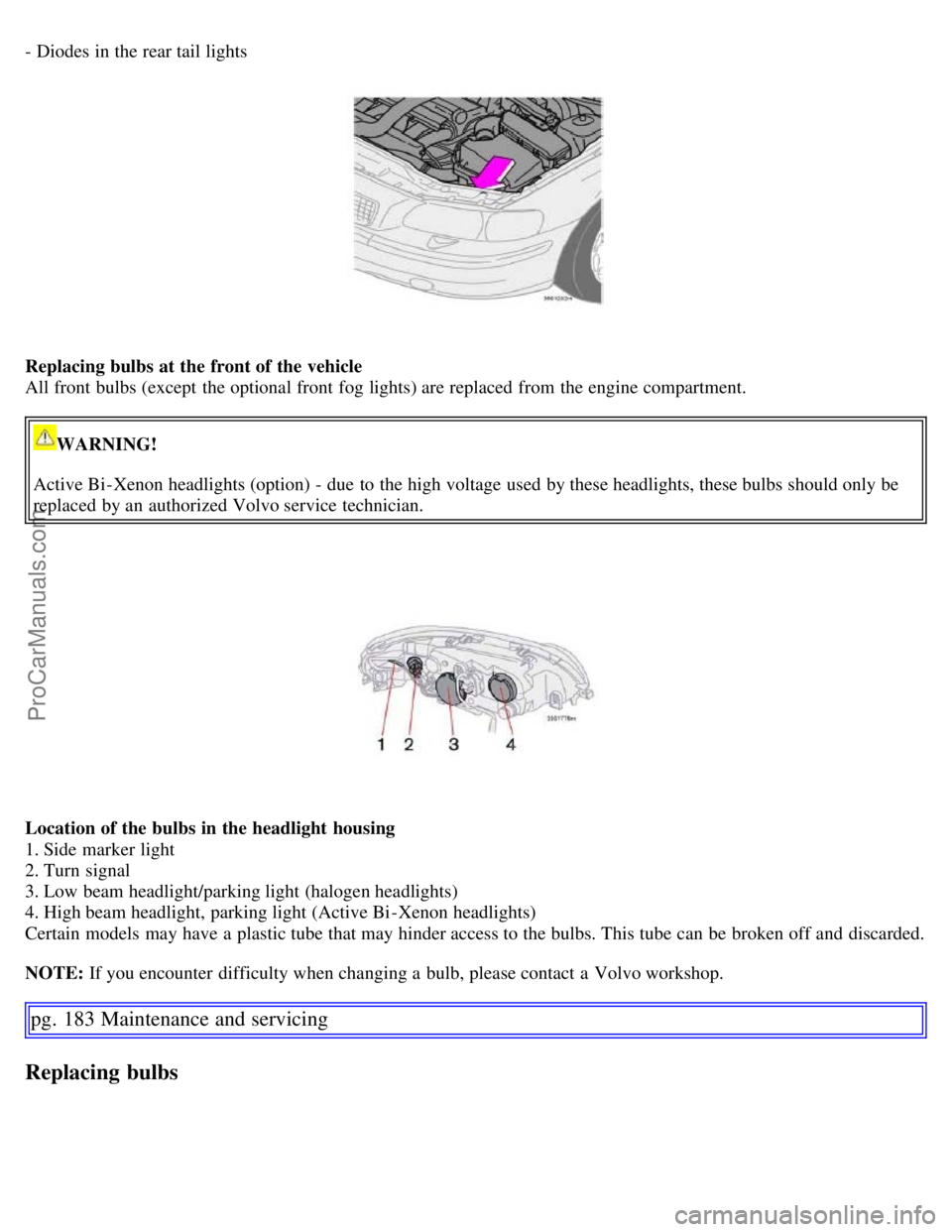
- Diodes in the rear tail lights
Replacing bulbs at the front of the vehicle
All front bulbs (except the optional front fog lights) are replaced from the engine compartment.
WARNING!
Active Bi -Xenon headlights (option) - due to the high voltage used by these headlights, these bulbs should only be
replaced by an authorized Volvo service technician.
Location of the bulbs in the headlight housing
1. Side marker light
2. Turn signal
3. Low beam headlight/parking light (halogen headlights)
4. High beam headlight, parking light (Active Bi -Xenon headlights)
Certain models may have a plastic tube that may hinder access to the bulbs. This tube can be broken off and discarded.
NOTE: If you encounter difficulty when changing a bulb, please contact a Volvo workshop.
pg. 183 Maintenance and servicing
Replacing bulbs
ProCarManuals.com
Page 164 of 200
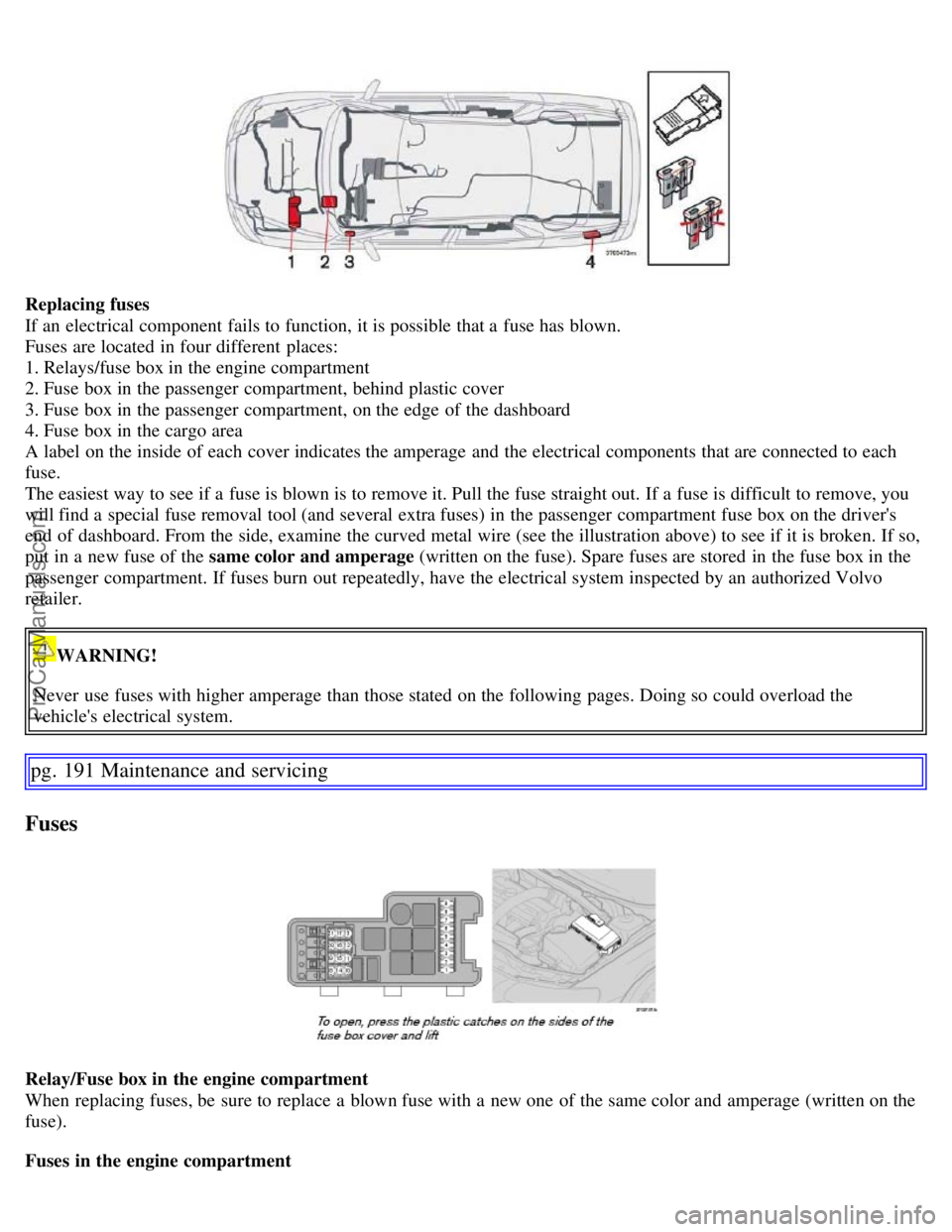
Replacing fuses
If an electrical component fails to function, it is possible that a fuse has blown.
Fuses are located in four different places:
1. Relays/fuse box in the engine compartment
2. Fuse box in the passenger compartment, behind plastic cover
3. Fuse box in the passenger compartment, on the edge of the dashboard
4. Fuse box in the cargo area
A label on the inside of each cover indicates the amperage and the electrical components that are connected to each
fuse.
The easiest way to see if a fuse is blown is to remove it. Pull the fuse straight out. If a fuse is difficult to remove, you
will find a special fuse removal tool (and several extra fuses) in the passenger compartment fuse box on the driver's
end of dashboard. From the side, examine the curved metal wire (see the illustration above) to see if it is broken. If so,
put in a new fuse of the same color and amperage (written on the fuse). Spare fuses are stored in the fuse box in the
passenger compartment. If fuses burn out repeatedly, have the electrical system inspected by an authorized Volvo
retailer.
WARNING!
Never use fuses with higher amperage than those stated on the following pages. Doing so could overload the
vehicle's electrical system.
pg. 191 Maintenance and servicing
Fuses
Relay/Fuse box in the engine compartment
When replacing fuses, be sure to replace a blown fuse with a new one of the same color and amperage (written on the
fuse).
Fuses in the engine compartment
ProCarManuals.com
Page 165 of 200

No.Amperage
1. ABS 30
2. ABS 30
3. Headlight washers (certain models) 35
4. -
5. Auxiliary lights (option) 20
6. Starter motor relay 35
7. Windshield wipers 25
8. Fuel pump 15
9. Transmission control module (R-models) 15
10. Ignition coils, engine control module 20
11. Throttle pedal sensor, A/C compressor, e -box fan 10
12. Engine control module, fuel injectors, mass airflow sensor 15
13. Throttle housing control module 10
14. Heated oxygen sensor 20
15. Crankcase ventilation heater, solenoid valves 10
16. Driver's side low beam headlight 20
17. Passenger's side low beam headlight 20
18. -
19. Engine control module feed, engine relay 5
20. Parking lights 15
21. -
pg. 192 Maintenance and servicing
Fuses
Fuse box in the passenger compartment, behind the plastic cover
This fuse box is located behind the plastic cover below the steering wheel. When replacing a blown fuse, be sure to
replace it with a new one of the same color and amperage (written on the fuse).
No. Amperage
1. Heated passenger's seat (option) 15
2. Heated driver's seat (option) 15
ProCarManuals.com
Page 167 of 200
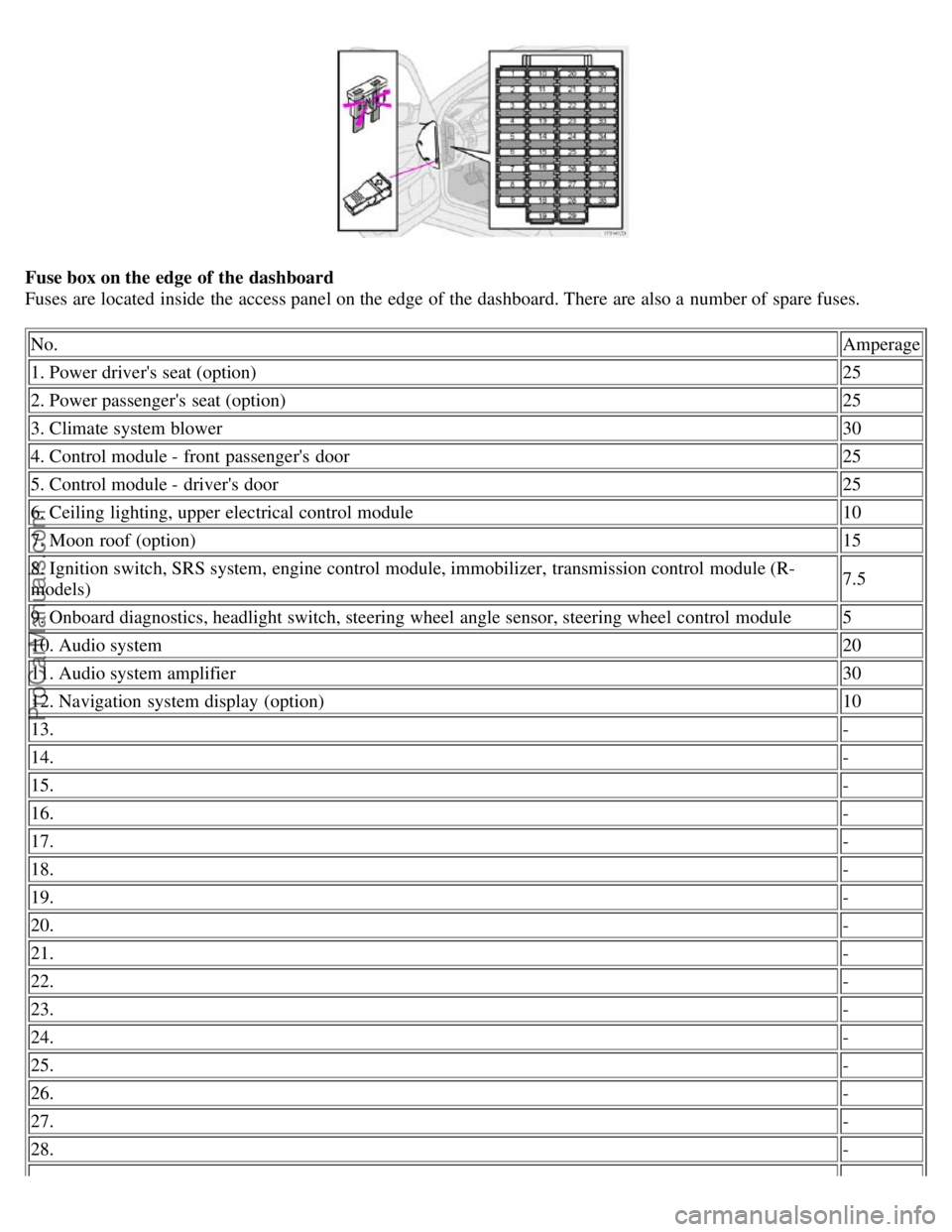
Fuse box on the edge of the dashboard
Fuses are located inside the access panel on the edge of the dashboard. There are also a number of spare fuses.No. Amperage
1. Power driver's seat (option) 25
2. Power passenger's seat (option) 25
3. Climate system blower 30
4. Control module - front passenger's door 25
5. Control module - driver's door 25
6. Ceiling lighting, upper electrical control module 10
7. Moon roof (option) 15
8. Ignition switch, SRS system, engine control module, immobilizer, transmission control module (R-
models) 7.5
9. Onboard diagnostics, headlight switch, steering wheel angle sensor, steering wheel control module 5
10. Audio system 20
11. Audio system amplifier 30
12. Navigation system display (option) 10
13. -
14. -
15. -
16. -
17. -
18. -
19. -
20. -
21. -
22. -
23. -
24. -
25. -
26. -
27. -
28. -
ProCarManuals.com
Page 170 of 200
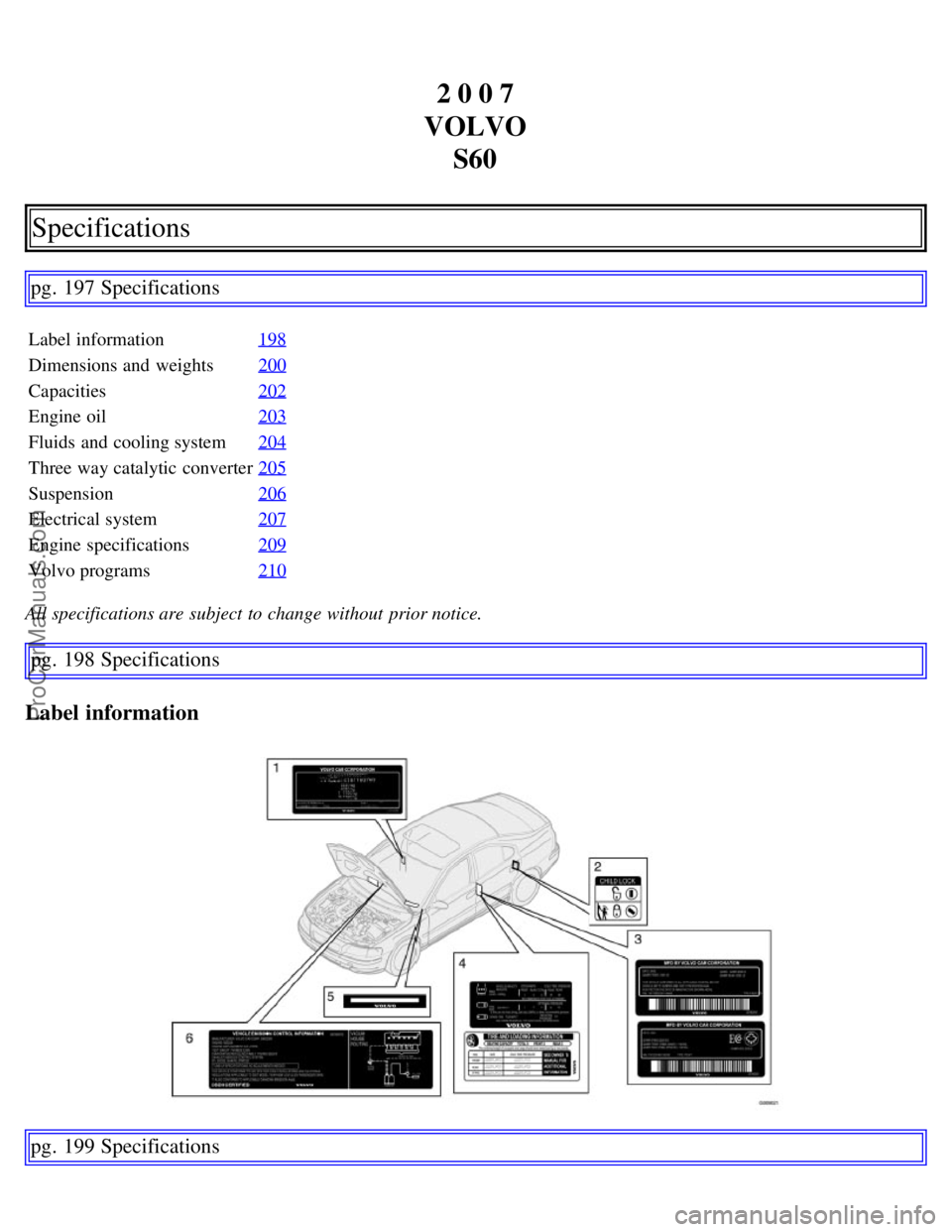
2 0 0 7
VOLVO S60
Specifications
pg. 197 Specifications
Label information 198
Dimensions and weights200
Capacities202
Engine oil203
Fluids and cooling system204
Three way catalytic converter205
Suspension206
Electrical system207
Engine specifications209
Volvo programs210
All specifications are subject to change without prior notice.
pg. 198 Specifications
Label information
pg. 199 Specifications
ProCarManuals.com
Page 173 of 200
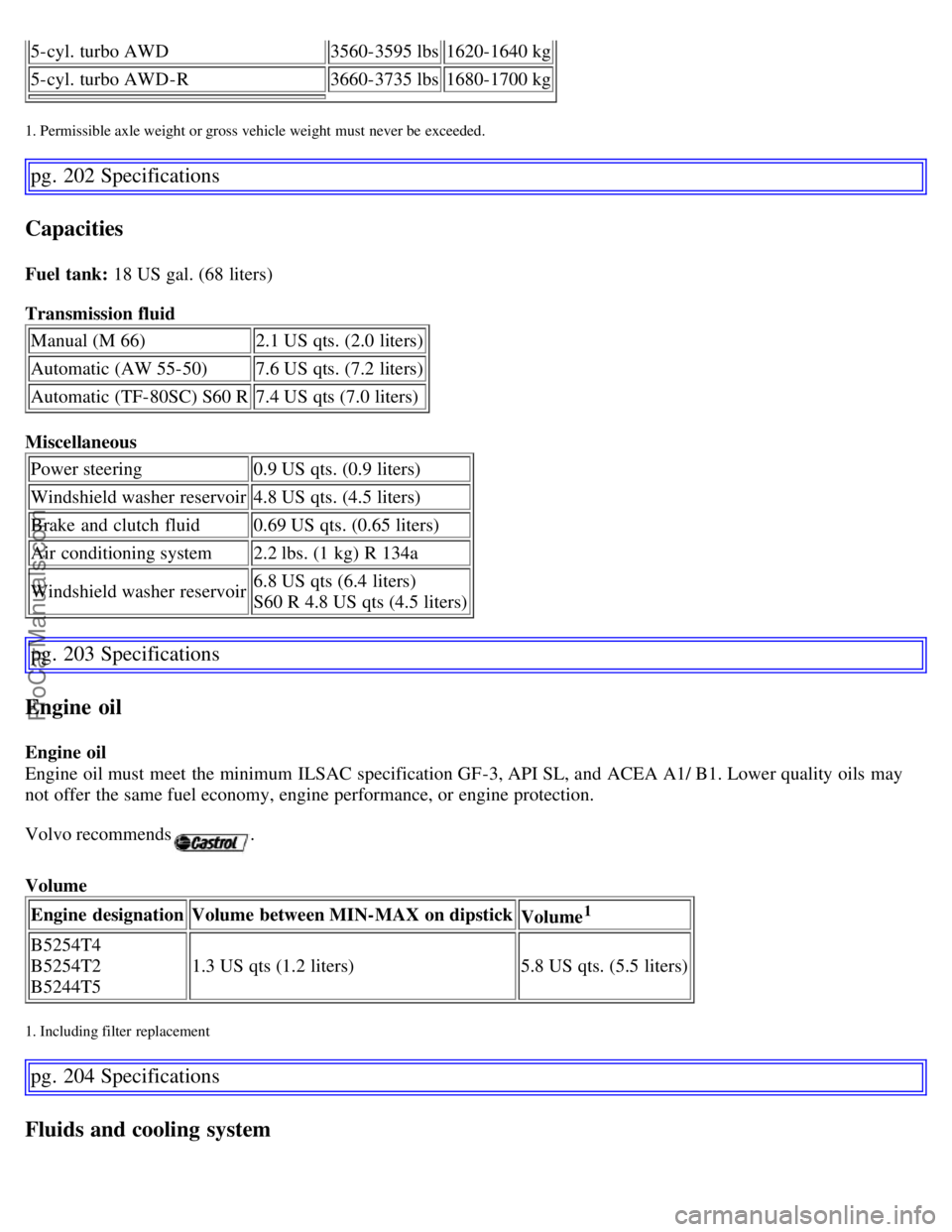
5-cyl. turbo AWD3560-3595 lbs1620-1640 kg
5-cyl. turbo AWD-R 3660-3735 lbs1680-1700 kg
1. Permissible axle weight or gross vehicle weight must never be exceeded.
pg. 202 Specifications
Capacities
Fuel tank: 18 US gal. (68 liters)
Transmission fluid
Manual (M 66) 2.1 US qts. (2.0 liters)
Automatic (AW 55-50) 7.6 US qts. (7.2 liters)
Automatic (TF-80SC) S60 R 7.4 US qts (7.0 liters)
Miscellaneous Power steering 0.9 US qts. (0.9 liters)
Windshield washer reservoir 4.8 US qts. (4.5 liters)
Brake and clutch fluid 0.69 US qts. (0.65 liters)
Air conditioning system 2.2 lbs. (1 kg) R 134a
Windshield washer reservoir 6.8 US qts (6.4 liters)
S60 R 4.8 US qts (4.5 liters)
pg. 203 Specifications
Engine oil
Engine oil
Engine oil must meet the minimum ILSAC specification GF-3, API SL, and ACEA A1/ B1. Lower quality oils may
not offer the same fuel economy, engine performance, or engine protection.
Volvo recommends
.
Volume Engine designation Volume between MIN-MAX on dipstick
Volume
1
B5254T4
B5254T2
B5244T51.3 US qts (1.2 liters)
5.8 US qts. (5.5 liters)
1. Including filter replacement
pg. 204 Specifications
Fluids and cooling system
ProCarManuals.com
Page 174 of 200
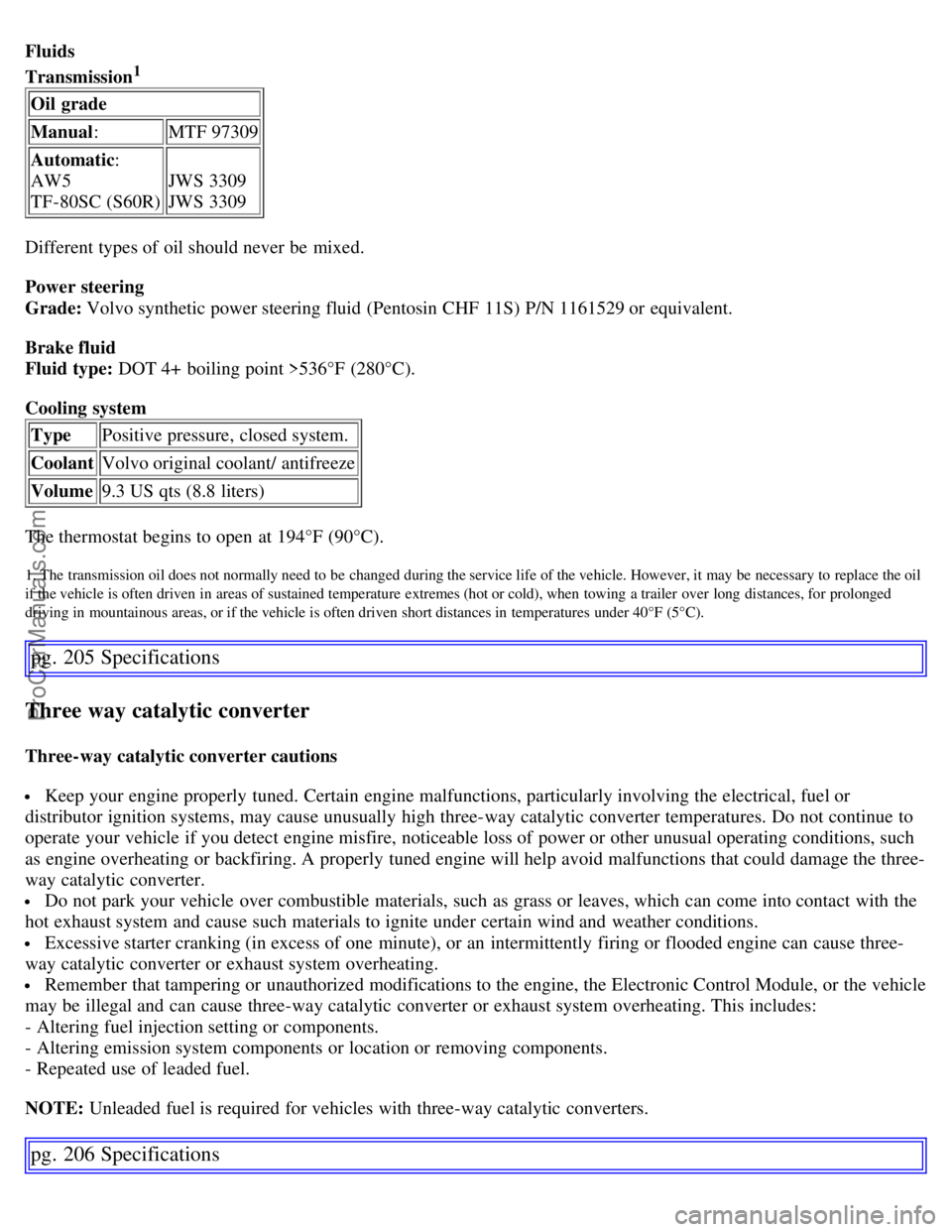
Fluids
Transmission1
Oil grade
Manual: MTF 97309
Automatic :
AW5
TF-80SC (S60R) JWS 3309
JWS 3309
Different types of oil should never be mixed.
Power steering
Grade: Volvo synthetic power steering fluid (Pentosin CHF 11S) P/N 1161529 or equivalent.
Brake fluid
Fluid type: DOT 4+ boiling point >536°F (280°C).
Cooling system Type Positive pressure, closed system.
Coolant Volvo original coolant/ antifreeze
Volume 9.3 US qts (8.8 liters)
The thermostat begins to open at 194°F (90°C).
1. The transmission oil does not normally need to be changed during the service life of the vehicle. However, it may be necessary to replace the oil
if the vehicle is often driven in areas of sustained temperature extremes (hot or cold), when towing a trailer over long distances, for prolonged
driving in mountainous areas, or if the vehicle is often driven short distances in temperatures under 40°F (5°C).
pg. 205 Specifications
Three way catalytic converter
Three-way catalytic converter cautions
Keep your engine properly tuned. Certain engine malfunctions, particularly involving the electrical, fuel or
distributor ignition systems, may cause unusually high three-way catalytic converter temperatures. Do not continue to
operate your vehicle if you detect engine misfire, noticeable loss of power or other unusual operating conditions, such
as engine overheating or backfiring. A properly tuned engine will help avoid malfunctions that could damage the three-
way catalytic converter.
Do not park your vehicle over combustible materials, such as grass or leaves, which can come into contact with the
hot exhaust system and cause such materials to ignite under certain wind and weather conditions.
Excessive starter cranking (in excess of one minute), or an intermittently firing or flooded engine can cause three-
way catalytic converter or exhaust system overheating.
Remember that tampering or unauthorized modifications to the engine, the Electronic Control Module, or the vehicle
may be illegal and can cause three-way catalytic converter or exhaust system overheating. This includes:
- Altering fuel injection setting or components.
- Altering emission system components or location or removing components.
- Repeated use of leaded fuel.
NOTE: Unleaded fuel is required for vehicles with three-way catalytic converters.
pg. 206 Specifications
ProCarManuals.com
Page 176 of 200
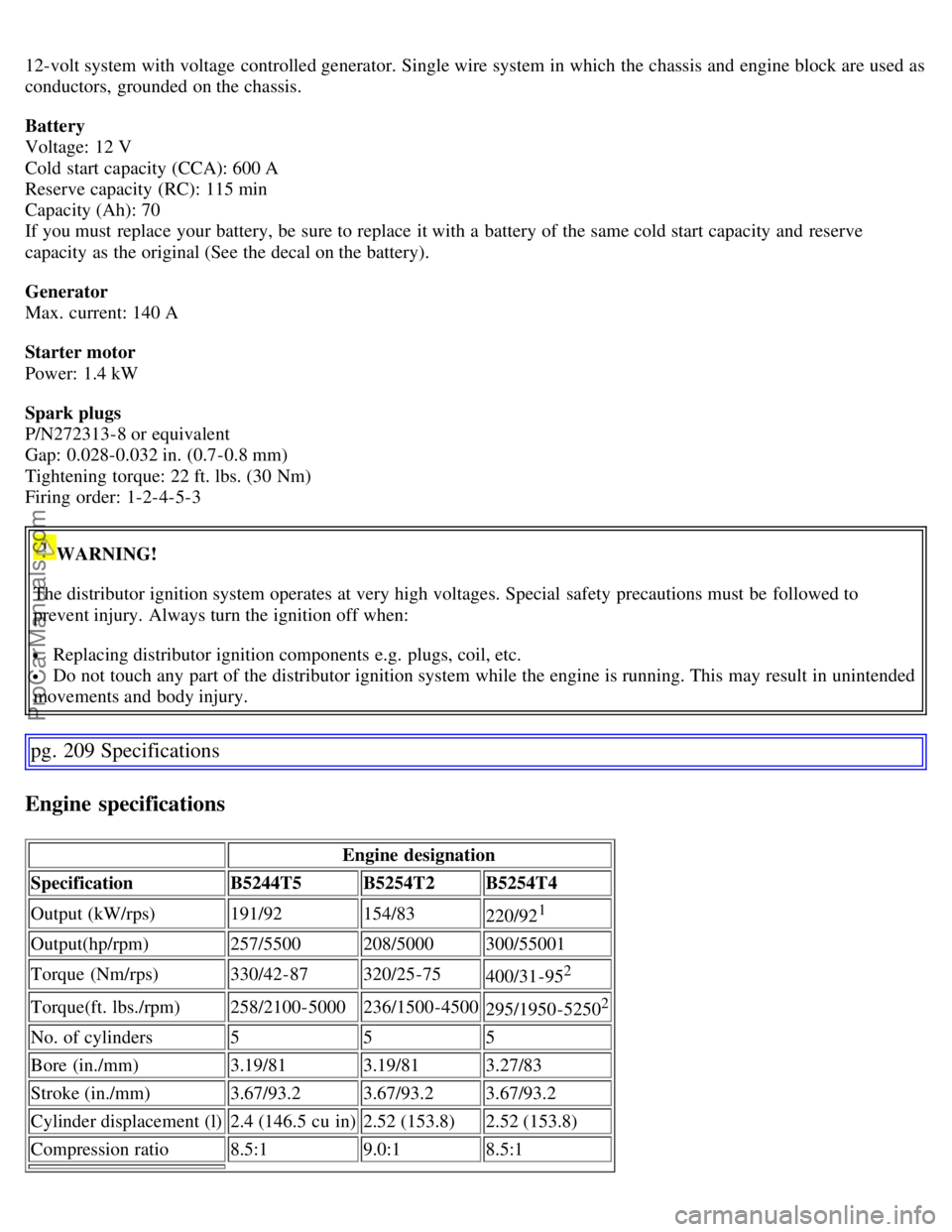
12-volt system with voltage controlled generator. Single wire system in which the chassis and engine block are used as
conductors, grounded on the chassis.
Battery
Voltage: 12 V
Cold start capacity (CCA): 600 A
Reserve capacity (RC): 115 min
Capacity (Ah): 70
If you must replace your battery, be sure to replace it with a battery of the same cold start capacity and reserve
capacity as the original (See the decal on the battery).
Generator
Max. current: 140 A
Starter motor
Power: 1.4 kW
Spark plugs
P/N272313-8 or equivalent
Gap: 0.028-0.032 in. (0.7-0.8 mm)
Tightening torque: 22 ft. lbs. (30 Nm)
Firing order: 1-2-4-5-3
WARNING!
The distributor ignition system operates at very high voltages. Special safety precautions must be followed to
prevent injury. Always turn the ignition off when:
Replacing distributor ignition components e.g. plugs, coil, etc.
Do not touch any part of the distributor ignition system while the engine is running. This may result in unintended
movements and body injury.
pg. 209 Specifications
Engine specifications
Engine designation
Specification B5244T5B5254T2B5254T4
Output (kW/rps) 191/92154/83
220/92
1
Output(hp/rpm) 257/5500208/5000300/55001
Torque (Nm/rps) 330/42-87320/25-75
400/31-95
2
Torque(ft. lbs./rpm) 258/2100-5000236/1500-4500
295/1950-52502
No. of cylinders 555
Bore (in./mm) 3.19/813.19/813.27/83
Stroke (in./mm) 3.67/93.23.67/93.23.67/93.2
Cylinder displacement (l) 2.4 (146.5 cu in)2.52 (153.8)2.52 (153.8)
Compression ratio 8.5:19.0:18.5:1
ProCarManuals.com